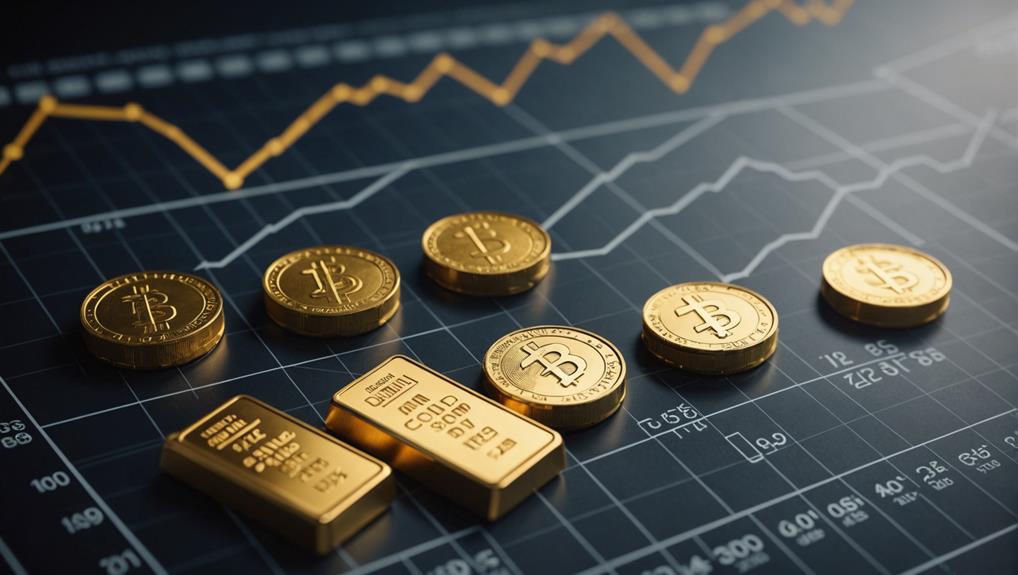During inflationary periods, gold investment strategies are essential for wealth preservation and protection against the erosive effects of rising prices.
Gold has a long-standing reputation as a reliable store of value, often proving resilient compared to other assets in times of economic uncertainty.
Investors have a range of options to explore, including gold ETFs, physical bullion, and shares in gold mining companies, each with its own set of risks and rewards.
Navigating these choices strategically is key to optimizing investment outcomes. Understanding the nuances of these strategies is crucial for building a resilient and diversified portfolio.
Key Insights
- Diversify with Gold ETFs: Invest in gold ETFs for exposure to gold prices without physical storage hassles.
- Consider Physical Gold: Hold physical gold to preserve purchasing power as a tangible asset in economic uncertainty.
- Leverage Gold Mining Stocks: Gain leveraged exposure to gold prices through gold mining stocks.
- Utilize Gold IRAs: Incorporate gold in retirement portfolios using Gold IRAs for tax advantages.
- Balance with Diversification: Enhance portfolio diversification by adding gold, which has low correlation with traditional assets.
Historical Role of Gold

Gold has historically acted as a hedge against inflation, maintaining its purchasing power in times of economic uncertainty. Central banks have long held substantial gold reserves due to its reputation for wealth preservation.
In the past, currencies were directly linked to gold under the gold standard, ensuring stability and a reliable store of value. Even after the shift away from this standard, gold's intrinsic value has persisted, establishing it as a reliable safeguard against inflation.
Its value tends to rise during periods of inflation, reflecting increased demand from investors seeking stability. Additionally, its low correlation with traditional assets enhances its appeal as a diversification tool, safeguarding portfolios against inflationary pressures.
Factors Influencing Gold's Effectiveness
Gold's effectiveness as a hedge against inflation is influenced by several important factors, including central bank policies, geopolitical tensions, and market sentiment. These elements impact the price of gold and its demand during economic uncertainties, making it a valuable asset for investors.
Gold's low correlation with traditional assets strengthens its role as a diversification tool in inflation-protected portfolios.
Gold Price Drivers
Influential factors such as inflation, central bank policies, geopolitical uncertainties, and market demand all play a crucial role in shaping gold prices. When inflation expectations are high, investors often turn to gold as a safe haven asset to safeguard their wealth.
Central bank decisions, especially regarding interest rates and money supply, have a significant impact on the attractiveness of gold. For instance, lower interest rates tend to increase gold's appeal as it does not yield interest.
Geopolitical instability and market volatility further enhance gold's reputation as a reliable investment during times of unrest. Fluctuations in gold prices can also be influenced by market demand, which is influenced by investor sentiment and economic conditions.
Understanding these key drivers is essential for making well-informed decisions on gold investment strategies, particularly during periods of inflation.
Inflationary Impact Analysis
The effectiveness of gold as an inflation hedge is influenced by a multitude of factors, including central bank policies, money supply growth, and market sentiment. Central bank actions, such as interest rate decisions and quantitative easing, have a significant impact on gold prices during periods of inflationary pressure.
Gold's performance as an inflation hedge historically correlates closely with money supply growth, showcasing its sensitivity to inflation dynamics. Moreover, global economic uncertainties and geopolitical events play a role in shaping investor demand for gold, thereby influencing its price movements.
To navigate gold investment strategies effectively, it is crucial to understand these interconnected factors that collectively determine gold's ability to preserve purchasing power in times of inflation.
Gold Demand Trends

Examining gold demand trends uncovers crucial factors that influence market dynamics. The jewelry market in India and China represents the largest segment of gold consumption. Moreover, emerging markets and investors seeking safe-haven assets play a significant role in driving up gold prices.
Central banks' gold purchases further impact overall demand, underscoring the multifaceted nature of gold investment strategies during inflationary times.
Jewelry Market Dynamics
The jewelry market, representing approximately 50% of global gold demand, significantly influences gold prices and market dynamics.
Gold jewelry holds immense cultural significance, particularly in countries like India and China, where traditions surrounding weddings and festivals drive substantial demand.
Consumer behavior, which is cyclical and influenced by seasonal variations, plays a crucial role in shaping the dynamics of the jewelry market.
Economic conditions and fluctuations in gold prices directly impact the affordability and desirability of gold jewelry, thereby influencing overall market trends.
When gold prices increase, consumers may opt for lower-demand products or alternative materials, while price drops can lead to a surge in purchases, underscoring the delicate balance between economic factors and cultural preferences within this sector.
Emerging Market Influence
Emerging markets, including India and China, are pivotal in shaping global gold demand trends due to their significant jewelry consumption. As these regions experience economic growth, the demand for gold intensifies, impacting global prices.
In addition to jewelry consumption, central banks in emerging markets, such as Russia and China, hold substantial gold reserves, further contributing to overall demand. Economic uncertainties and currency fluctuations within these markets often lead to increased safe-haven investment in gold, highlighting the crucial role of emerging markets in driving global economic stability and influencing investment strategies.
Central Bank Purchases
Central banks' increased gold purchases in 2021, the highest in a decade, reflect a global trend towards diversification and risk hedging amid economic uncertainties.
Leading the charge are nations like Russia and China, bolstering their gold reserves to reduce dependence on the US dollar.
This strategic reserve enrichment not only underscores gold's safe-haven appeal but also serves as protection against potential currency devaluation.
In essence, these actions highlight gold's enduring value as a reliable store of wealth in times of uncertainty.
Gold Vs. Other Inflation Hedges
When compared to traditional inflation hedges, gold has consistently proven to be a superior performer in times of rising inflation. Historically, gold bullion, coins, and bars have outperformed assets such as Treasury bonds.
While Treasury bonds offer income and security, gold provides protection against both inflation and currency devaluation. Its value typically increases during periods of high inflation, showcasing its reliability as an inflation hedge.
Gold ETFs present investors with a convenient way to access gold's inflation-protective qualities without the need for physical storage.
Diversification Benefits

Gold's role in a diversified investment portfolio goes beyond mere stability; it can significantly reduce overall risk, especially in times of inflation. The diversification benefits of gold arise from its unique characteristic of having a low correlation with traditional assets like stocks and bonds. This attribute makes gold a valuable tool for safeguarding against economic uncertainties, enhancing the resilience of an investment portfolio, particularly during inflationary periods.
Incorporating gold into an investment portfolio offers a range of diversification benefits:
- Risk Reduction: Gold's low correlation with other assets helps to mitigate overall portfolio risk.
- Inflation Hedge: Gold tends to appreciate in value when inflation rates rise, providing a useful hedge against inflation.
- Economic Stability: Gold's presence in a portfolio can contribute to overall stability during times of economic uncertainty.
- Safe-Haven Asset: With its historical reputation as a safe-haven asset, gold offers a sense of security to investors.
- Value Appreciation: Gold's tendency to increase in value during inflationary periods can enhance overall portfolio performance.
Investment Options for Gold
Investors seeking to capitalize on the diversification benefits of gold during inflationary periods have a range of investment options to consider.
Physical gold, in the form of coins and bars, serves as a tangible asset that effectively preserves purchasing power.
For those looking to avoid the hassle of storing physical gold, Gold ETFs offer a convenient alternative by providing exposure to gold prices.
Gold mining stocks present an opportunity for leveraged exposure to gold prices, potentially leading to higher returns.
Additionally, gold IRAs enable investors to incorporate gold into their retirement portfolios, offering tax advantages in the process.
Each investment option comes with its own set of unique benefits, allowing investors to tailor their choices based on their risk tolerance and investment objectives.
Risks and Considerations

Considering gold investments during inflationary periods necessitates a comprehensive evaluation of the associated risks and factors. The value of gold can be influenced by price fluctuations and central bank policies, underscoring the importance of assessing both the potential risks and rewards.
Key factors to consider include:
- Opportunity Costs: Comparing gold to assets like Treasuries, which provide regular interest payments.
- Price Volatility: The unpredictable nature of gold's future trajectory requires a thorough risk analysis.
- Impact of Central Bank Policies: These policies can either drive gold prices up or down, impacting investment outcomes significantly.
- Income Generation Limitation: Gold does not offer dividends or interest, limiting potential income streams for investors.
- Diversification Benefits: While gold can enhance portfolio diversification, it is essential to strike a balance between risks and rewards.
Expert Recommendations
Experts advise adopting a diversified investment approach tailored to individual financial objectives and risk tolerance to effectively navigate the complexities of gold investments during periods of inflation.
Strategies commonly employed in gold investment include investing in gold ETFs, physical gold, or gold mining stocks, capitalizing on gold's historical role as a hedge against inflation.
Diversifying a portfolio with gold can help mitigate the risks associated with escalating prices. It is crucial to seek guidance from financial advisors to craft a gold investment strategy that aligns with personal risk tolerance and long-term goals.
Keeping abreast of economic indicators, central bank policies, and geopolitical developments can enhance decision-making processes.
Conclusion
To sum up, gold investment strategies offer a robust approach to preserving purchasing power during inflationary periods. Understanding gold's historical significance, the factors influencing its effectiveness, and comparing it to other inflation hedges can help investors make well-informed decisions.
Diversifying through various gold investment options and conducting thorough risk assessments can enhance portfolio resilience. Tailored expert recommendations aligned with individual financial goals and risk tolerance are essential for navigating economic uncertainties and maximizing the benefits of gold investments.
For more information and expert guidance on gold investments, please contact:
The Gold Information Network
11900 Biscayne Blvd, Ste 127B, Miami, FL 33181
(305) 449-9094
https://goldinfo.net







